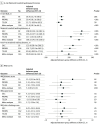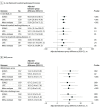Home-Based Walking Exercise and Supervised Treadmill Exercise in Patients With Peripheral Artery Disease: An Individual Participant Data Meta-Analysis
- PMID: 37733346
- PMCID: PMC10514734
- DOI: 10.1001/jamanetworkopen.2023.34590
Home-Based Walking Exercise and Supervised Treadmill Exercise in Patients With Peripheral Artery Disease: An Individual Participant Data Meta-Analysis
Abstract
Importance: Few people with lower extremity peripheral artery disease (PAD) participate in supervised treadmill exercise covered by the Center for Medicare and Medicaid Services. In people with PAD, the benefits of home-based walking exercise, relative to supervised exercise, remain unclear.
Objective: To study whether home-based walking exercise improves 6-minute walk (6MW) more than supervised treadmill exercise in people with PAD (defined as Ankle Brachial Index ≤0.90).
Data sources: Data were combined from 5 randomized clinical trials of exercise therapy for PAD using individual participant data meta-analyses, published from 2009 to 2022.
Study selection: Of the 5 clinical trials, 3 clinical trials compared supervised treadmill exercise to nonexercise control (N = 370) and 2 clinical trials compared an effective home-based walking exercise intervention to nonexercise control (N = 349).
Data extraction and synthesis: Individual participant-level data from 5 randomized clinical trials led by 1 investigative team were combined. The 5 randomized clinical trials included 3 clinical trials of supervised treadmill exercise and 2 effective home-based walking exercise interventions.
Main outcomes and measures: Change in 6MW distance, maximum treadmill walking distance, and Walking Impairment Questionnaire at 6-month follow-up. The supervised treadmill exercise intervention consisted of treadmill exercise in the presence of an exercise physiologist, conducted 3 days weekly for up to 50 minutes per session. Home-based walking exercise consisted of a behavioral intervention in which a coach helped participants walk for exercise in or around home for up to 5 days per week for 50 minutes per session.
Results: A total of 719 participants with PAD (mean [SD] age, 68.8 [9.5] years; 46.5% female) were included (349 in a home-based exercise clinical trial and 370 in a supervised exercise trial). Compared with nonexercise control, supervised treadmill exercise was associated with significantly improved 6MW by 32.9 m (95% CI, 20.6-45.6; P < .001) and home-based walking exercise was associated with significantly improved 6MW by 50.7 m (95% CI, 34.8-66.7; P < .001). Compared with supervised treadmill exercise, home-based walking exercise was associated with significantly greater improvement in 6MW distance (between-group difference: 23.8 m [95% CI, 3.6, 44.0; P = .02]) but significantly less improvement in maximum treadmill walking distance (between-group difference:-132.5 m [95% CI, -192.9 to -72.1; P < .001]).
Conclusions and relevance: In this individual participant data meta-analyses, compared with supervised exercise, home-based walking exercise was associated with greater improvement in 6MW in people with PAD. These findings support home-based walking exercise as a first-line therapy for walking limitations in PAD.
Conflict of interest statement
Figures


References
-
- Gerhard-Herman MD, Gornik HL, Barrett C, et al. . 2016 AHA/ACC Guideline on the Management of Patients With Lower Extremity Peripheral Artery Disease: Executive Summary: A Report of the American College of Cardiology/American Heart Association Task Force on Clinical Practice Guidelines. Circulation. 2017;135(12):e686-e725. doi:10.1161/CIR.0000000000000470 - DOI - PMC - PubMed
-
- Divakaran S, Carroll BJ, Chen S, Shen C, Bonaca MP, Secemsky EA. Supervised exercise therapy for symptomatic peripheral artery disease among Medicare beneficiaries between 2017 and 2018: participation rates and outcomes. Circ Cardiovasc Qual Outcomes. 2021;14(8):e007953. doi:10.1161/CIRCOUTCOMES.121.007953 - DOI - PMC - PubMed
Publication types
MeSH terms
Grants and funding
LinkOut - more resources
Full Text Sources
Medical

